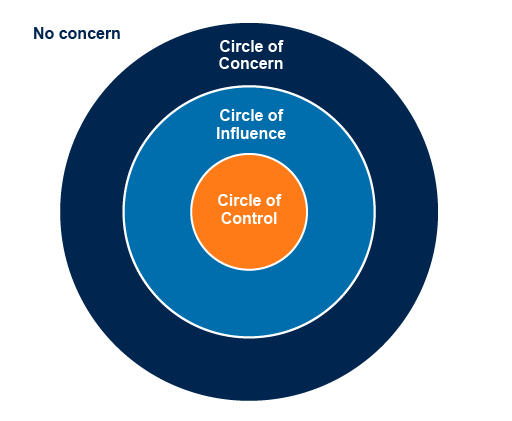2.1 Control and influence
A famous Greek philosopher Epictetus advised ‘To make the best of what is in our power, and take the rest as it occurs’. He said:
Some things are in our control and others not. Things in our control are opinion, pursuit, desire, aversion, and, in a word, whatever are our own actions. Things not in our control are body, property, reputation, command, and, in one word, whatever are not our own actions.
So what does that even mean? Part of working in new ways is about understanding that we need to learn to focus on the things we can change and learn to accept there are just some things we cannot change. Of course, that is easier said than done. We can often feel out of control, which can lead to feelings of failure, helplessness and even hopelessness. This is not good for our mental health and can result in high levels of anxiety and stress.
How the COVID-19 pandemic affected our thoughts about control
As a leader you may feel that you should have control and be in control of situations, but the pandemic made many of us feel more out of control than ever (Hope, 2021). During this time some of the only things we could have in our control was to wash our hands and follow guidelines on meeting with other people. ‘Dealing with Covid was not in our daily repertoire of stressors’, said Susan Albers, a clinical psychologist at the Cleveland Clinic who, in her career, has focused on people with control issues. ‘There is no handbook for coping with Covid. There are no role models or well-documented research that points to how to effectively cope with a global pandemic. Covid requires a new set of coping skills that many people have never had to exercise’ (Hope, 2021).
We learned from this that we cannot really control anyone or anything other than ourselves. We feel like we should control others to get the best results, and you might find yourself saying that you feel like you have lack of control over various areas, departments or even situations. What you are really saying is that if you could have control of the people in them, you could then get what you needed done! However, control is a mere illusion. Richards (2018) said that leadership is about influence, not control, and the best leaders inspire and motivate rather than dictate.
What do you have control over?
The things you can have control over as a leader include:
- your reactions
- your attitudes
- your biases.
Activity 6 Record your ABCs
This short activity is to help you understand that external events do not cause emotions, but they do affect our beliefs. It is a good warm up exercise in self-awareness before you move onto the next section of the course. It will create a grounding exercise to help you reflect on how you react to events and give you some ideas of what you could do next time.
- A stands for the activating event that triggers your inner dialogue
- B stands for the beliefs you formed after the event
- C stands for the consequences or how you feel.
The scenario:
Imagine that you have tried to log onto your laptop and your Wi-Fi has gone down or is unstable. You become anxious imagining you won’t make it to your virtual meeting on time and it is a big one with the rest of your team and a member of the senior leadership team. What are your ABCs in this situation?
Answer
The activating trigger in this scenario is the broadband going down.
Your beliefs might have included thinking that it looked like you were not working or were slacking off, because joining a meeting on time is important to you. You might believe that being late for or even missing the meeting would damage your reputation and affect performance review conversations.
As a consequence, you might have started to panic and hit the keyboard, frantically tried to log on via your mobile phone instead, and eventually phoned the broadband provider and shouted at them.
Bouncing back from perceived loss of control
As part of understanding yourself as a hybrid leader you will be looking at what you can influence and control. Sometimes there will be things you are concerned about but you cannot influence, and that can be tough.
Watch this video: Circle of Influence - From The 7 Habits of Highly Effective People [Tip: hold Ctrl and click a link to open it in a new tab. (Hide tip)]
In the video you heard about how we operate in two circles:
- The circle of concern – the things we care about but can have very little impact on and no control over.
- The circle of influence – things we can make an impact on and have influence over.
This idea is taken from Stephen Covey’s book The 7 Habits of Highly Effective People (Covey, 1989). Covey distinguishes between reactive people, who focus their energy on the circle of concern, and proactive people, who focus on the circle of influence.
Focusing on the circle of concern is a waste of energy and actually causes influence to shrink. The video showed an example of this and, as a result, he alienated the executive team surrounding him. One executive in the video, however, was proactive – he took initiative and focused on his own circle of influence. Working to complement the strength of the leader who focused on the circle of concern, and in the process that proactive executive created powerful support and increased his sphere of influence.
The circle of control
Stephen Covey’s model has been adapted by psychologist Claire Newton to include a third circle – the circle of control.
The inner circle of control is about things we have direct control over. This includes our own thoughts and behaviours. It can also include our decisions, choices, moods, work ethics and even our words.
When you lead with influence, you build a dialogue with your team, rather than telling them what to do. You encourage the team and model positive behaviours and language, rather than demanding cooperation. With this approach, you’re likely to earn the team’s respect and enhance their engagement. Using influence, you change the way the team perceives or reacts to situations, which allows you to get the best out of team members, even under challenging conditions.
The key takeaways around control and influence are:
- If you cannot control it, do not get stressed about it.
- If you cannot influence it, do not get upset about it.
- Focus on what you can change, not on what you cannot.
Influence is better than control
To become a better leader, Richards (2018) believes that you must ‘recognise that your ability to influence is much more crucial than your power to control. Leadership is about service’. Move away from micromanaging, as that can indicate you do not trust your employees. Instead take the time to delegate to others. It is possible to control and be a leader, but it is very hard to control and influence all at the same time, and you might at times need to get out of your own way and let others be guided by you.
Activity 7 Your circles of control and influence
In this activity you will reflect on your own:
- circles of control
- circles of influence
- circles of concern
A space has been provided below for you to type your notes, but you could create your own digital board (e.g. using tools such as Padlet, Miro or Mural) or just draw one on a piece of paper and use sticky notes to annotate it. What you choose to apply this to could be in your role as a hybrid leader or it could be about something in your life in general, but it is a good way to really ground your thoughts about what you can control and have control over and actually what you cannot control.

